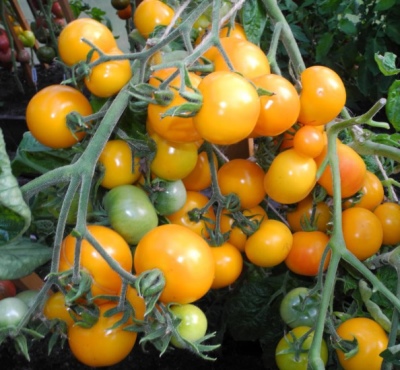
- Authors: Russia
- Category: grade
- Appointment: fresh consumption, for pickling and preserving
- Ripening period: early
- Ripening time, days: 75-85
- Growing conditions: for open ground
- Bush size: undersized
- Bush height, cm: 35
- Bush characteristic: compact
- Ripe fruit color: deep orange
Such an unusual name does not cause any special associations among gardeners. However, this variety definitely deserves attention from consumers. It is necessary to carefully study the features of growing such a culture and its biological characteristics.
Description of the variety
Nizhny Novgorod kudyablik is an attractive Russian tomato. It is intended for outdoor cultivation. The plant forms low compact growing bushes. The height reaches 0.35 m. The development of the trunk is characteristic; it is believed that it is not even a determinant, but a superdeterminant.
The main qualities of the fruit
The berries of the Nizhny Novgorod kudyablik have a pronounced orange color. The usual mass of tomatoes is 0.05 kg. They are typically rounded geometric shapes. The skin has a smooth surface. It is also characterized by a decent density.
Taste characteristics
Nizhny Novgorod kudyablik has a good, dense pulp. Berries are used for fresh consumption. You can also preserve them at home. The crop is sometimes used even in barrel salting, to obtain a paste, for cooking dried dishes. Almost all people like the taste.
Ripening and fruiting
This is an attractive early tomato. Ripeness is reached in 75-85 days. Traditionally, the countdown starts from the emergence of fresh growth. Harvesting is usually possible during July and August. The specific result depends on the weather and agricultural practices.
Yield
The variety belongs to the productive group. The highest productivity reaches 4 kg per 1 m2. However, it is obtained only with high-quality, well-thought-out agricultural technology. The collection per 1 bush is approximately equal to 1 kg.
The timing of planting seedlings and planting in the ground
Sowing seeds is strongly advised 60 days before the expected time of transshipment into open land. Such a period is always selected individually, taking into account the peculiarities of the development of the plant. Pay attention to the specifics of the region and the actual weather. For the normal development of seedlings, a light, loose soil mixture with increased nutritional properties is needed. Seedlings sometimes need additional lighting, especially in areas where there is little sun.

Growing tomato seedlings is an extremely important process, because it largely depends on whether the gardener can harvest at all. All aspects must be taken into account, from seedbed preparation to planting in the ground.
Landing scheme
There should be no more than 5 bushes per 1 m2. But even a lower concentration is unlikely to be productive. However, the final decision must be made by the gardeners themselves.

Growing and care
There is no particular need to form, tie to a support and remove stepsons. It must be remembered that the Nizhny Novgorod kudyablik is susceptible to late blight. The prevention of this disease and the timely elimination of pathology, if it does arise, should be given maximum attention. Also, pre-emptive treatments for Alternaria are strictly required. The cultivation of such a culture is quite within the power of even novice gardeners.
Seedlings are usually planted in a universal soil for growing tomatoes. It is necessary to maintain a temperature for her at least 22 degrees. Systematic watering is also important for seedlings. It is advisable to keep early shoots in well-lit places. Before transshipment into open ground, hardening is imperative.
Good protection is provided by the drug "Ordan", which stops infection with late blight and Alternaria. The first time they process plantings with it, when 4 early leaves appear. Further processing is repeated once a week. But they must be stopped when there are 20 days left before the harvest. There will be no other special subtleties during cultivation.




A plant needs different micronutrients at each stage of growth. All fertilizers can be divided into two groups: mineral and organic. Folk remedies are often used: iodine, yeast, bird droppings, eggshells.
It is important to observe the rate and period of feeding. This also applies to folk remedies and organic fertilizers.


Review overview
The Nizhny Novgorod kudyablik is really unpretentious. It is capable of producing a powerful harvest of beautiful berries with a sweet taste. Under the condition of preventive treatments, problems practically do not arise. Temperature fluctuations are tolerated by this variety without any problems. There will be almost no complaints about growing it, especially if you follow the official recommendations.

























































































